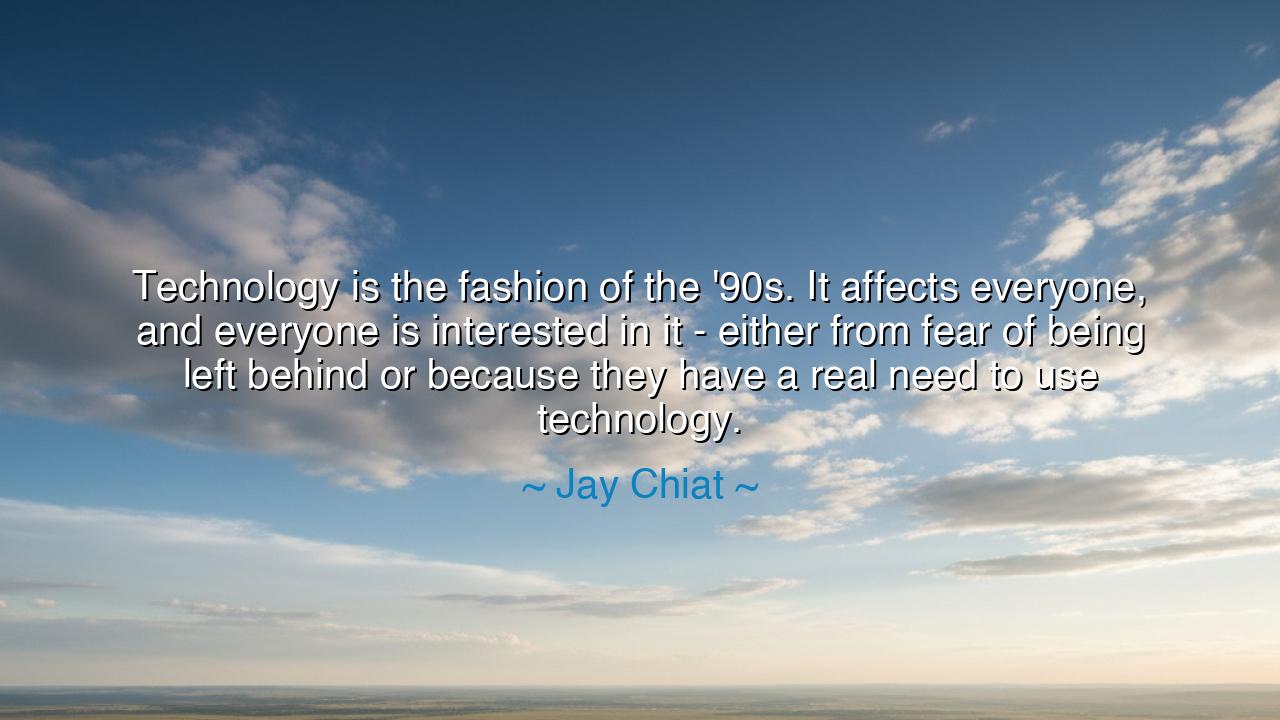
Technology is the fashion of the '90s. It affects everyone, and
Technology is the fashion of the '90s. It affects everyone, and everyone is interested in it - either from fear of being left behind or because they have a real need to use technology.






Hear the words of Jay Chiat, pioneer of modern advertising and seer of cultural shifts, who declared: “Technology is the fashion of the ’90s. It affects everyone, and everyone is interested in it—either from fear of being left behind or because they have a real need to use technology.” These words are not mere commentary on a decade past, but a timeless revelation: that when new inventions surge through society, they become not only tools, but symbols, compelling both awe and fear. In his time, Chiat saw how the computer and the internet were no longer curiosities of laboratories, but garments the whole world was forced to wear, willingly or not.
The origin of this saying lies in the cultural revolution of the 1990s. It was an age when technology moved from the margins to the center of human life. Personal computers entered homes, email replaced letters, and the internet began to weave together the world with invisible threads. Like fashion, it touched every class, every generation, every industry. Some embraced it eagerly, like new clothes that made them shine; others adopted it reluctantly, lest they be marked as outdated, as relics of a fading era. Chiat, master of perception, saw clearly that the driving forces were twofold: fear of being left behind, and the pressing need to use technology in order to survive in the changing world.
Consider how this played out in the rise of the World Wide Web. At first, many dismissed it as a toy, a novelty of the young or the eccentric. But soon, companies realized that to remain invisible online was to risk death. Stores, banks, schools—all had to adapt or perish. Much like fashion trends that sweep across a city, the internet did not allow neutrality. One either stepped forward clothed in the new fabric of connectivity, or one was left unclothed and vulnerable in the eyes of progress. Chiat’s words captured the urgency of that transformation.
History gives us older examples as well. When the printing press spread across Europe in the fifteenth century, it too became a kind of “fashion.” Those who learned to read and publish gained power, while those who clung to parchment and script risked irrelevance. Knowledge had changed its clothing, and society had to change with it. The fearful resisted, but the tide was unstoppable. Just as Chiat observed in his own time, people adapted either out of terror of being left behind, or out of true hunger for what the new technology could provide.
The heart of Chiat’s wisdom is this: when technology becomes a cultural garment, no one is spared. It does not remain in the hands of the few; it spreads into the daily rhythms of the many. Its adoption is not always born of joy—often it is born of necessity. Fear itself becomes a driver of change, pushing the reluctant into the arms of the future. Yet the wise do not rely only on fear; they seek to understand, to master, to use the new tools with purpose, rather than being swept blindly along.
The lesson for us is as urgent now as it was in the ’90s. Today, new fashions arise in the form of artificial intelligence, genetic engineering, virtual reality, and beyond. Once again, society feels the twin pull of fear and necessity. We must not be passive wearers of this new fabric, but thoughtful designers of how it will shape our lives. To merely adopt technology from terror of being left behind is to remain a slave to it; to embrace it with understanding is to make it serve human flourishing.
So I say to you, children of tomorrow: do not despise the “fashion” of technology, for it reveals the pulse of your age. But neither should you follow it blindly. Learn its language, master its tools, and ask always how it may serve the dignity of man rather than enslave it. For Jay Chiat spoke truly: technology affects everyone. You cannot avoid its garment, but you can choose how to wear it—with fear, or with wisdom. And the wise will always be the ones who turn fashion into destiny.






AAdministratorAdministrator
Welcome, honored guests. Please leave a comment, we will respond soon